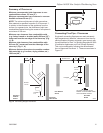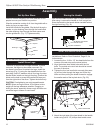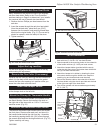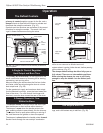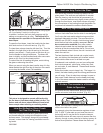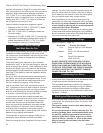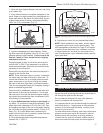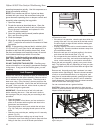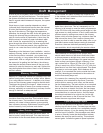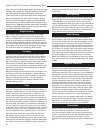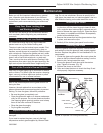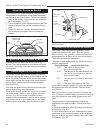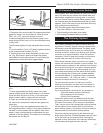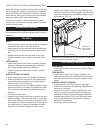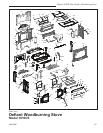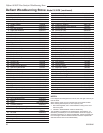
19
Defiant 1610CE Non-Catalytic Woodburning Stove
30003846
Draft Management
A stove is part of a system, which includes the chimney,
the operator, the fuel, and the home. The other parts of
the system will affect how well the stove works. When
there is a good match between all the parts, the system
works well.
Wood stove or insert operation depends on natural
(unforced) draft. Natural draft occurs when the exhaust
is hotter (and therefore lighter) than the outdoor air at
the top of the chimney. The bigger the temperature
difference, the stronger the draft. As the hot gases rise
through the chimney they provide suction or ‘draw’ that
pulls air into the stove for combustion. A slow, lazy fire
with the stove’s air inlets fully open indicates a weak
draft. A brisk fire, supported only by air entering the
stove through the normal inlets, indicates a good draft.
The stove’s air inlets are passive; they regulate how
much air can enter the stove, but they don’t move air
into it.
Depending on the features of your installation - steel or
masonry chimney, inside or outside the house, matched
to the stove’s outlet or oversized - your system may
warm up quickly, or it may take a while to warm up and
operate well. With an ‘airtight’ stove, one which restricts
the amount of air getting into the firebox, the chimney
must keep the stove’s exhaust warm all the way to the
outdoors in order for the stove to work well. Some chim-
neys do this better than others. Here’s a list of features
and their effects.
Masonry Chimney
Masonry is a traditional material for chimneys, but it can
perform poorly when it serves an ‘airtight’ stove. Mason-
ry is a very effective ‘heat sink’ - it absorbs a lot of heat.
It can cool the chimney gases enough to diminish draft.
The bigger the chimney, the longer it takes to warm up.
It’s often very difficult to warm up an outdoor masonry
chimney, especially an oversized one, and keep it warm
enough to maintain an adequate draft.
Steel Chimney
Most factory-made steel chimneys have a layer of
insulation around the inner flue. This insulation keeps
the chimney warm. The insulation is less dense than
masonry, so a steel chimney warms up more quickly
than a masonry chimney. Steel doesn’t have the good
looks of masonry, but it performs much better.
Indoor/Outdoor Location
Because the chimney must keep the smoke warm, it’s
best to locate it inside the house. This uses the house
as insulation for the flue and allows some heat release
into the home. An indoor chimney won’t lose its heat
to the outdoors, so it takes less heat from the stove to
heat it up and keep it warm.
Chimney Height
The common wisdom tells us that a taller flue draws
better than a short one. This isn’t necessarily so. If a
chimney is tall enough to meet the safety requirements
of the 2/3/10 foot rule, then adding more height isn’t the
right answer to a draft problem. In fact it could make the
problem worse by adding more mass to the chimney
system, which must be warmed up, a distance from the
heat source (the stove). Don’t make a chimney taller
unless you must in order to meet the safety rules, or un-
less there’s some nearby feature causing a downdraft.
Even then, there are downdraft-preventing chimney
caps available, which are probably the smarter choice.
Flue Sizing
The inside size of a chimney for an ‘airtight’ stove
should match the size of the stove’s flue outlet. When
a chimney serves an airtight stove, more is not better;
in fact, it can be a disadvantage. Hot gases lose heat
faster as they travel slower through a chimney; if we
vent a stove with a 152mm (6”) flue collar [181 sq cm
(28 sq in area) into a 254 x 254 mm (10 x 10”) flue, the
gases slow to one third their original speed. This allows
the gases to cool more rapids, which weakens draft
strength. If an oversized flue is also outside the house,
the heat it absorbs gets transferred to the outdoor air
and the flue usually stays cool.
It is common for a masonry flue, especially one serving
a fireplace, to be oversized for the stove. It can take
quite a while to warm up such a flue, and the results
can be disappointing. The best solution to an oversized
flue is an insulated steel chimney liner, the same diam
-
eter as the stove or insert’s flue outlet; the liner keeps
the exhaust warm, and the result is a stronger draft. An
uninsulated liner is a second choice - the liner keeps
the exhaust restricted to its original size, but the hot
gases still must warm up the air around the liner. This
makes the warm-up process take longer.
Pipe & Chimney Layout
Every turn the exhaust must take as it travels to the
chimney top will slow it down. The ideal pipe and chim-
ney layout is to vent vertically into a completely straight
and vertical chimney. If you are starting from scratch,
use this layout if possible. If the stovepipe must elbow
to enter a chimney, locate the thimble about midway
between the stove top and the ceiling. This achieves
several goals: it allows the gases to speed up before



